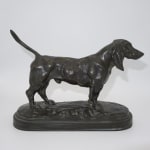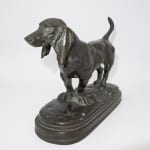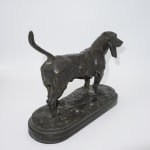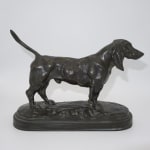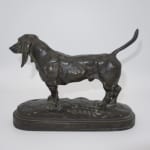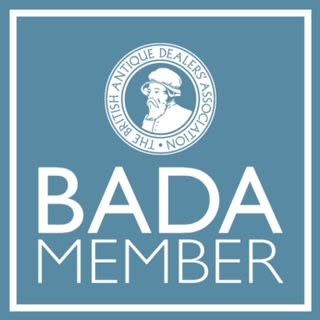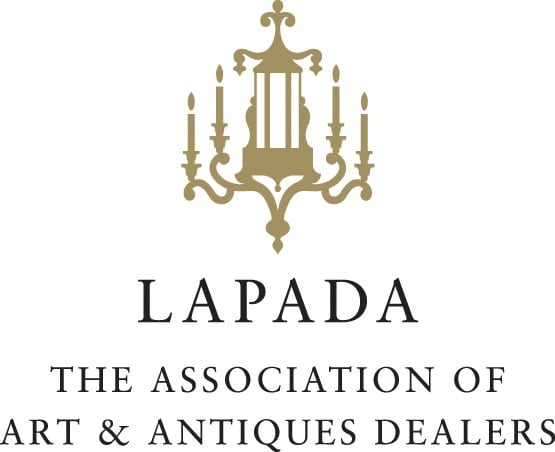ANTOINE-LOUIS BARYE (1795-1875)
Further images
Provenance
Private collection, Shropshire
Literature
Christopher Payne, Animals in Bronze, 1986.
Jane Horswell, Bronze Sculpture of 'Les Animaliers' Reference and Guide, 1971
Standing Basset bronze with black patination by French sculptor Antoine-Louis Barye (1795-1875). This was first modelled in the 1830's and listed in the sculptor's first catalogue in 1847. This example is probably from the 1880's. Signed ''Barye' to base.
Antoine-Louis Barye was born in Paris in 1796 and was the son of a goldsmith. He was apprenticed to the steel engraver Fourrier aged thirteen making decorative metalwear for the French army and on commissions for the goldsmith Biennais for Emperor Napoleon. In 1816 he became a pupil of the sculptor Bosio who was of the neoclassical school of Canova and David, followed soon after by the painter Gros, part of the romantic school and known for his lively battle scenes with horses. He was admitted to the Ecole des Beaux-Arts in 1818.
He began modelling small animals for Fauconnier, goldsmith to the court and when not working, he would study the animals at the Jardin des Plantes zoo in Paris where he was also allowed to dissect dead animals to make studies and detailed drawings of their anatomy. He was fascinated by zoology and natural history and attended classes taught by Geoffroy St. Hilaire, the chairman of the zoology department at the Musée National d'Histoire Naturelle.
In the Salon of 1831 he exhibited the "Tiger devouring a Gavial' which created a sensation with its energy and ferocity and it was a turning point in his career. It was purchased by the Minister of the Interior for the Luxembourg Palace and other commissions soon followed. In 1833 he exhibited the 'Lion and Serpent' in plaster which was purchased by the State and King Louis-Phillipe's sons, the Duc d'Orléans and the Duc de Nemours purchased several other works. Barye was rewarded after the exhibition with the Croix de la Légion d'Honneur, by royal command.
Barye's important commisssions included the 'Striding Lion' and other animals to decorate the July Column in the Place de la Bastille and his 'Seated Lion' which he had first exhibited in plaster was commissioned in bronze by the State for the Tuileries Gardens.
In 1839 Barye set up his own foundry and gallery and produced his first catalogue of his work in September 1847, with 107 different models listed. In 1854 he became Professor of drawing zoology at the Museum of Natural History until his death and was elected to the Académie des Beaux Arts in 1868.
After his death in 1876, 125 models of his work were sold to the Ferdinand Barbédienne foundry who continued to produce castings of high quality.
Barye is regarded as the 'father of the animalier school' and one of its greatest artists. His son Alfred Barye was also an animalier sculptor.
His sculptures became hugely popular with American collectors visiting Paris from the late 1850's onwards who also introduced his work to other collectors in the States and examples of his work can now be found in collections and museums around the world.





